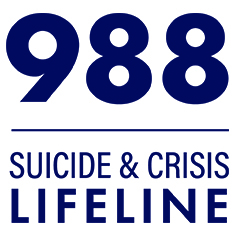The Power of Listening
June 25, 2021

In honor of Pride Month, we had the pleasure of speaking with Sam Brinton about LGBTQ youth mental health and lived experience in suicide prevention. A leading advocate for LGBTQ youth worldwide, Brinton is The Trevor Project’s vice president of advocacy and government affairs and a member of SPRC’s Lived Experience Advisory Committee.
Q1. The Trevor Project just released the results of its third annual national survey on LGBTQ youth mental health. Could you talk about some of the most important findings?
Brinton: Each time that we ask LGBTQ youth about their mental health, we learn a little bit more—that’s the power of listening. And with this latest survey, we knew we were going to learn a lot, coming in a pandemic and a time of great change, and what we learned was just how diverse the experiences of LGBTQ youth are as they relate to identity and race.
For example, we found that more than half of trans and non-binary youth had seriously considered attempting suicide in the past year. And when we asked about suicide attempts, we found 12% of white youth had attempted suicide compared to 31% of Native/Indigenous, 21% of Black, 21% of multiracial, 18% of Latinx, and 12% of Asian and Pacific Islander LGBTQ youth.
This shows there is not an equal amount of risk among LGBTQ youth, and they are not all getting the same levels of resources. So, when we have discussions about Black Lives Matter, COVID-19, or suicide prevention, we need to be thinking about disparity on multiple levels.
As a trans person myself, I am commonly talked about based on my increased suicide risk as a trans person compared to a lesbian, gay, bisexual, or cisgender person. But as a mixed-race Native/Indigenous person, that part of my identity is almost always forgotten. So, our national survey really shows we need to address the multiple layers of risk that a person is experiencing.
Q2. What steps can the prevention community take right now to reverse these trends, especially as they relate to the diverse experiences and disparities you just highlighted for us?
Brinton: Half of our respondents reported discrimination based on their race and identity, including two-thirds of Black LGBTQ youth. So, if you are trying to create a space where affirmation around sexual orientation and gender identity is paramount, you need to also be addressing racial and ethnic discrimination.
I know it can be overwhelming to think about how to stop all discrimination, so here’s a really easy first step that saves lives: use a person’s pronouns. Trans and non-binary youth who have their pronouns respected by all the people they live with attempt suicide at half the rate of those who don’t have their pronouns respected.
We can’t all march in the streets, we can’t all pass a law, but we can all respect a person’s pronouns.
Q3. This year’s survey asked respondents where they find joy and strength. What can we do, in both our professional and personal lives, to help foster the resilience of LGBTQ young people?
Brinton: LGBTQ youth are making it through a pandemic, surviving and staying true to themselves, so we wanted to find out what helps them stay resilient. Some of the ways they said they found joy was getting support in school, learning about their history, connecting to others, playing video games, finding representation in media, and listening to music. These are all really important things we can build off of.
If LGBTQ youth are saying they find joy by being supported in schools, let’s make sure their mental health is being supported there too. A third of schools across America have no mention of suicide prevention in any of their policies. Students are returning to classrooms, where maybe they will have better access to supportive environments, but if there’s no suicide prevention plan in place, that’s a major gap.
Q4. You’ve done incredible work to advocate for LGBTQ youth by drawing on insights from your own experience, such as your work to end conversion therapy. Could you talk about the value of integrating lived experience in suicide prevention efforts?
Brinton: Survivor-based advocacy and lived experience are two sides of the same coin. We talk a lot in the LGBTQ community about the concept of “nothing about us without us.” To see that concept consolidated and organized by SPRC and others is a powerful acknowledgment that lived experience is about not just a person’s individual story but about listening, learning, and growing together.
As a person who has felt like I didn’t want to live anymore more times than I can count, I am really glad I had people who said, “I’ve also had that experience, I’ve also felt that way.” I had the true blessing of calling The Trevor Project, of finding a counselor who heard me and said, “You’re not the only one that feels this way, and you’re not alone.”
So, bringing lived experience into this work is kind of like a homecoming. I get to bring my experiences and my truth into a field that values them and is now starting to coalesce around them as respected. I am not a suicidology researcher, but I know what I experienced. And when enough of us with those experiences can share them, we can influence policy and intervention, prevention, and postvention practices and save lives, which is truly powerful.
This interview has been lightly edited for readability.
